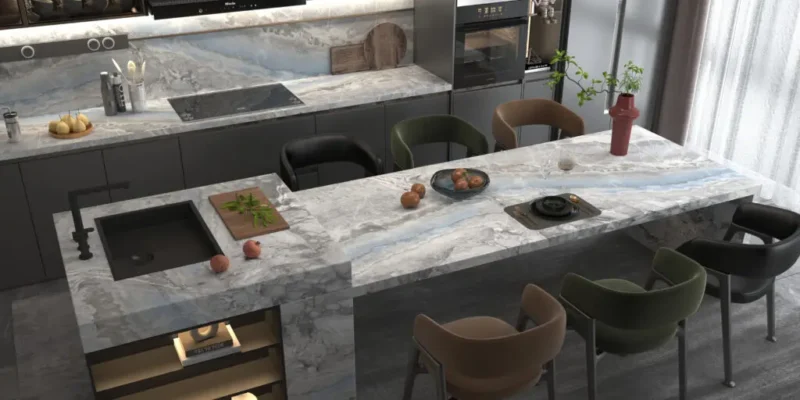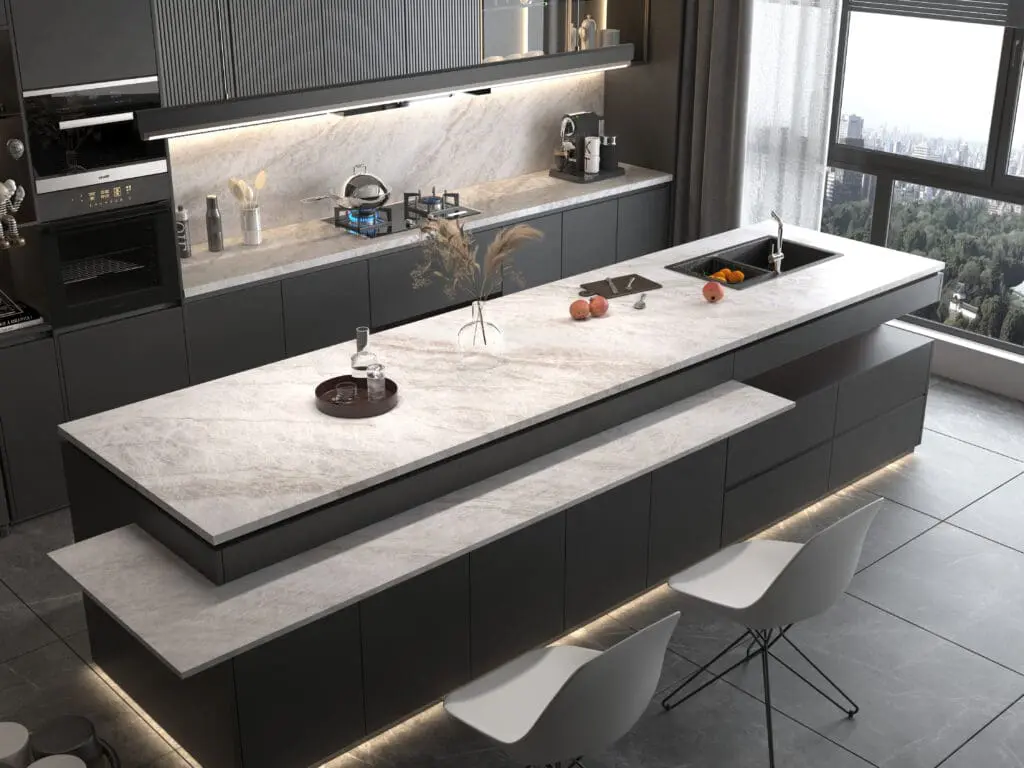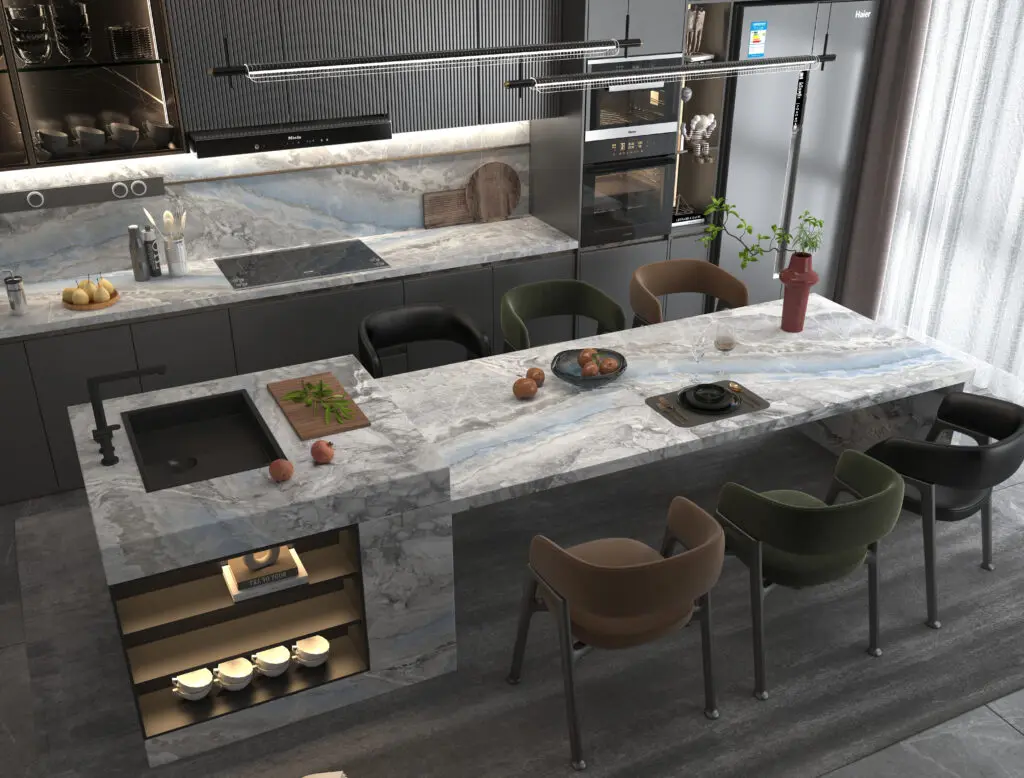


When it comes to modern kitchen design, homeowners in Ontario are often faced with the popular debate of Porcelain vs Quartz Countertops. Both materials have become top contenders in recent years thanks to their durability, aesthetic appeal, and versatility in fitting today’s lifestyle needs. While natural stones like granite and marble have long been admired, the shift toward engineered and high-performance surfaces is reshaping the market.
Porcelain and quartz countertops are leading this transformation, offering homeowners stylish, functional, and low-maintenance alternatives to traditional materials. Porcelain, made from refined clay and fired at extremely high temperatures, is valued for its strength, stain resistance, and sleek designs. Quartz, an engineered stone composed of natural quartz crystals mixed with resins, is equally admired for its durability, wide range of colors, and consistent finishes.
The decision between these two options isn’t always straightforward. Each material has unique benefits and potential drawbacks that should be considered based on your kitchen’s functionality, design goals, and budget. In this article, we’ll explore porcelain and quartz countertops in detail, outlining their pros and cons, and ultimately help you determine which one is the best fit for Ontario kitchens.

When evaluating countertop materials for modern kitchens in Ontario, porcelain has quickly gained a reputation as a high-end, forward-looking option. While it has been popular in Europe and Asia for decades, porcelain countertops are now emerging as a serious competitor in the North American market, particularly in design-conscious cities like Toronto and Ottawa. Understanding the advantages and disadvantages of porcelain countertops is crucial before making an investment.
Porcelain countertops are made from a type of ceramic material composed of refined clay, feldspar, and other natural minerals. These raw materials are subjected to extreme heat—often above 2,400°F—which creates a dense, non-porous surface that is remarkably durable. Unlike natural stone, which can vary in pattern and consistency, porcelain is engineered, meaning manufacturers can create surfaces in a wide variety of styles, including those that mimic marble, granite, concrete, or even wood.
This manufacturing flexibility is one of the main reasons homeowners are drawn to porcelain countertops: you can achieve the high-end aesthetic of natural stone without dealing with the same maintenance challenges.
Porcelain is known for its strength. Because it’s fired at such high temperatures, the material becomes harder than many types of natural stone. It is resistant to scratches, chips, and cracks, making it ideal for busy Ontario kitchens where food prep, heavy pots, and sharp knives are part of everyday use.
Homeowners who want a surface that will look “like new” for decades often appreciate this level of resilience. Unlike softer stones such as marble, porcelain is far less prone to etching from acidic foods or scratching from utensils.
One of the standout features of porcelain countertops is their ability to withstand extreme heat. You can place a hot pot or pan directly on the surface without fear of burning or discoloration—a quality that not all countertop materials share. For Ontario families who love cooking at home, this heat resistance is a practical and attractive benefit.
Because porcelain is non-porous, it does not absorb liquids. Coffee, wine, tomato sauce, and even oil will not leave behind stains when wiped up promptly. This makes porcelain particularly appealing in kitchens, where spills are inevitable. Unlike granite or marble, which require sealing to maintain resistance against staining, porcelain does not need regular sealing.
Porcelain can be manufactured to replicate virtually any material. Many porcelain slabs are designed to mimic the luxurious veining of marble, the industrial look of concrete, or the warm feel of wood. This versatility allows homeowners to achieve a wide variety of styles, from modern minimalist kitchens to classic traditional designs, all without the upkeep of natural stone.
Additionally, porcelain is available in ultra-thin slabs as well as thicker cuts, offering flexibility in design applications. It can be used not only for countertops but also for backsplashes, walls, and even flooring, creating a seamless and cohesive kitchen look.
Unlike quartz, porcelain is resistant to ultraviolet (UV) light. This means it won’t fade or discolor when exposed to sunlight over time. For Ontario homeowners with kitchens that feature large windows or open layouts with natural light, this UV stability ensures that countertops maintain their original color for years. It also makes porcelain suitable for outdoor kitchens—an increasingly popular trend in modern home design.
Porcelain’s non-porous quality also makes it highly hygienic. Bacteria, mold, and mildew cannot penetrate the surface, which helps maintain a clean and safe cooking environment. For families who prioritize health and safety, this feature is a major selling point.
While porcelain has a strong foothold in Europe, it is still relatively new in Ontario and other parts of North America. This means fewer local suppliers and fabricators specialize in porcelain, which can limit options and increase lead times. Finding an installer with specific porcelain experience may also take extra effort.
Porcelain countertops are generally considered a premium option. While they may be comparable in price to quartz or high-end granite, they are more expensive than budget-friendly alternatives like laminate, solid surface, or butcher block. For Ontario homeowners working with tight budgets, the higher upfront investment may be a drawback.
Porcelain slabs are extremely hard but also relatively thin compared to quartz or granite. This means they can be more brittle during the installation process. Professional installation is essential, as improper handling or cutting can result in cracks or breakage. The specialized equipment required for fabrication and installation can also contribute to higher overall project costs.
Because porcelain slabs are often thinner, the variety of edge profiles is more limited than with thicker materials like quartz or granite. Most porcelain countertops feature simple, modern edges such as straight or mitered, which may not appeal to homeowners who prefer ornate or traditional detailing.
Some homeowners report that porcelain feels colder than other materials, especially compared to quartz, which has a slightly warmer feel. While this may not be a dealbreaker, it’s worth noting for those who spend a lot of time in the kitchen.
To better understand where porcelain stands, it’s helpful to compare it against its competitors. For example:
Porcelain vs Quartz: Porcelain excels in UV resistance and heat resistance, while quartz offers more edge profile options and a slightly softer touch.
Porcelain vs Granite: Porcelain is non-porous and requires no sealing, whereas granite needs periodic sealing. Granite, however, may offer more natural variation in pattern.
Porcelain vs Marble: Porcelain mimics marble beautifully but without the susceptibility to etching and staining. Marble, however, remains unmatched in natural luxury appeal.
Porcelain countertops are an excellent choice for Ontario homeowners who want a modern, durable, and low-maintenance surface with a wide range of design options. They are particularly suited to:
Households with busy kitchens that need durability.
Homes with large windows or outdoor spaces where UV stability matters.
Homeowners seeking the look of marble or other high-end stones without the upkeep.
Modern or minimalist designs that benefit from sleek, thin slabs and seamless surfaces.
However, if budget is a top concern or if you want a wide range of ornate edge profiles, porcelain may not be the best fit. In these cases, quartz or granite might be a better match.

When homeowners in Ontario think about upgrading their kitchen countertops, they’re not only focused on the aesthetic appeal but also on the practical aspects of durability and maintenance. After all, a countertop isn’t just a design feature; it’s a functional surface that must withstand cooking, spills, daily wear, and years of use. In this section, we’ll compare porcelain vs quartz countertops from a performance standpoint—looking at resistance to scratches, heat, stains, and how much effort each material requires to keep in top shape.
Porcelain is renowned for its extreme hardness and resilience. Made by firing refined clay at very high temperatures, porcelain slabs are non-porous and dense, making them exceptionally durable.
Scratch resistance: Porcelain surfaces rank very high on the Mohs hardness scale, making them highly resistant to scratching from knives, pots, and everyday use.
Heat resistance: One of porcelain’s standout features is its ability to handle high temperatures. You can place hot pans directly on the surface without worrying about burns or scorch marks.
Impact resistance: While very strong, porcelain can be prone to chipping on edges if a heavy object strikes it directly. Proper edge finishing helps reduce this risk.
Quartz is also considered a highly durable option, engineered from natural quartz crystals mixed with resin.
Scratch resistance: Quartz is scratch-resistant but not as hard as porcelain. Cutting directly on quartz can eventually leave marks, so a cutting board is recommended.
Heat resistance: This is quartz’s weaker point. Because it contains resin, placing very hot pans on quartz can cause burn marks or discoloration.
Impact resistance: Quartz is excellent at absorbing shocks, making it less prone to chipping than porcelain.
Verdict: Porcelain wins on scratch and heat resistance, while quartz edges ahead on impact resistance.
Non-porous surface: Porcelain doesn’t absorb liquids, so stains from wine, coffee, or oils don’t penetrate.
Easy to clean: A simple wipe with warm water and mild detergent is usually enough.
No sealing required: Unlike granite or marble, porcelain never needs sealing, reducing long-term maintenance.
Non-porous surface: Like porcelain, quartz is non-porous and resists most stains.
Cleaning routine: Mild soap and water are sufficient for daily cleaning, but quartz can be slightly more sensitive to harsh chemicals (such as bleach).
No sealing required: Another low-maintenance option, quartz never requires sealing.
Verdict: Both are equally strong in stain resistance and daily care, though porcelain is a bit more chemical-resistant.
For families in Ontario, practicality matters. Winters bring salt and moisture inside, while kitchens often double as gathering spaces. Both porcelain and quartz countertops are long-lasting choices, but usage habits may determine which is better.
For heavy cooking households: Porcelain may be ideal, thanks to its heat and scratch resistance.
For families with kids: Quartz’s resistance to chipping from impacts might be more practical.
For modern kitchens with bold designs: Both materials are versatile, but porcelain often comes in ultra-thin slabs suitable for sleek, minimal looks.
Here’s a side-by-side comparison of Porcelain vs Quartz countertops for quick reference:
|
Feature |
Porcelain Countertops |
Quartz Countertops |
|---|---|---|
|
Scratch Resistance |
Extremely high – rarely scratches |
High, but can scratch with sharp objects |
|
Heat Resistance |
Excellent – handles hot pans with ease |
Moderate – can scorch due to resin content |
|
Impact Resistance |
Good, but edges may chip with heavy impact |
Very good – less prone to edge chipping |
|
Stain Resistance |
Excellent – fully non-porous |
Excellent – fully non-porous |
|
Maintenance |
Very low – no sealing, easy to clean |
Very low – no sealing, easy to clean |
|
Longevity |
20+ years with proper care |
20+ years with proper care |
Key Takeaway: If you prioritize heat and scratch resistance, porcelain is the clear winner. If you value impact durability and a slightly warmer feel, quartz may be the better choice. Both remain excellent, low-maintenance solutions for modern Ontario kitchens.

When it comes to deciding between porcelain vs quartz countertops, the right choice ultimately depends on your lifestyle, design goals, and budget. Both materials represent some of the most advanced and stylish options available for modern Ontario kitchens in 2025. Let’s recap and then guide you toward making a practical decision.
Porcelain shines for homeowners who prioritize:
Extreme durability – resistant to scratches, stains, and UV exposure.
A modern aesthetic – especially if you want sleek, minimalistic designs or a slab with very thin profiles.
Outdoor kitchen projects – its resistance to sun and weather makes it ideal for patios and BBQ areas.
Hygiene and easy cleaning – non-porous and perfect for families seeking low-maintenance surfaces.
Porcelain is also an excellent choice if you’re planning a high-end remodel and want a unique material that sets your kitchen apart.
Quartz remains the go-to choice for:
Classic elegance with durability – available in endless patterns, including marble-like veining.
Consistent performance indoors – resistant to scratches, stains, and daily wear.
Home value boost – highly recognized and trusted by Ontario homebuyers, making it a safe investment.
Design flexibility – thick slabs, bold edges, and seamless integration with backsplashes.
Quartz is ideal for homeowners who want timeless beauty with less concern about outdoor use.
While porcelain may sometimes cost slightly more upfront, it often lasts longer in outdoor or heavy-use spaces. Quartz, on the other hand, balances durability and aesthetics at a price point that works for most mid- to high-range renovations.
In Ontario, where kitchen remodels significantly impact resale value, either choice is a smart investment. The difference lies in how much you value ultra-modern looks (porcelain) versus classic luxury (quartz).
No matter which material you choose, installation quality makes or breaks the final result. Both porcelain and quartz require precise handling, professional cutting, and skilled installation to ensure durability and beauty. Working with a trusted Ontario countertop fabricator ensures:
Proper slab selection
Accurate measurement and fitting
Secure seam placement
Flawless finishing touches
There is no universal winner in the porcelain vs quartz countertops debate. Instead, the “winner” depends on your kitchen goals:
For ultra-modern Ontario kitchens or outdoor spaces → Porcelain takes the crown.
For timeless elegance, reliable performance, and widespread appeal → Quartz is unbeatable.
Either way, you’re choosing a surface that will last for years, elevate your cooking experience, and enhance the value of your home.
If you’re still undecided, consider visiting a local Ontario showroom to see both materials side by side. Feeling the texture, seeing the finishes in real light, and comparing slab options with your cabinetry will often make the decision much clearer.
At the end of the day, both porcelain and quartz countertops represent the future of kitchen design—durable, stylish, and highly functional. The right choice will align with your lifestyle and help transform your Ontario kitchen into a space that’s not only beautiful but also built for everyday living.